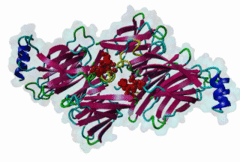LIG_Clathr_ClatBox_2
| Accession: | |
|---|---|
| Functional site class: | Clathrin box |
| Functional site description: | Clathrin boxes are found on cargo adaptor proteins. They interact with the N-terminal beta-propeller structure of Clathrin heavy chain. Beside the "classical" motif, some variants have been described for various types of adaptor proteins. The same protein can bear several subtypes of Clathrin boxes. |
| ELMs with same func. site: | LIG_Clathr_ClatBox_1 LIG_Clathr_ClatBox_2 |
| ELM Description: | This variant clathrin box motif (also called the W box) is found in tandem arrangement with a "classical" clathrin box, (LIG_Clathr_ClatBox_1) in a subgroup of cargo adaptor proteins enriched in nerve terminals: the amphiphysins. It is also found in sorting nexin-9. Both motifs bind the beta propeller structure of Clathrin heavy chain with a similar affinity (Ramjaun,1998, Slepnev,2000) but at distinct sites and while the classical clathrin box assumes an extended conformation, the W box is compact and helical (Miele,2004). A synergistic effect of appropriately spaced type 1 and 2 clathrin boxes on clathrin assembly and recruitment has been shown in vitro (Drake,2001). Amphiphysin 1 is the dominant autoantigen of paraneoplastic stiff-man syndrome. |
| Pattern: | .[NP]W[DES].W |
| Pattern Probability: | 0.0000015 |
| Present in taxons: | Eukaryota Gallus gallus Homo sapiens Mus musculus Rattus norvegicus |
| Interaction Domain: |
Clathrin_propel (PF01394)
Clathrin propeller repeat
(Stochiometry: 1 : 1)
|
Clathrin is the main component of the coat that decorates the cytosolic face of carrier vesicles mediating protein and lipid transport in the endocytic and late secretory pathways. In vivo the multimerisation of the clathrin heterohexamer (known as triskelion) and the clathrin-mediated vesicular trafficking are regulated through a complex network of interactions involving clathrin and a number of accessory proteins. Clathrin boxes are 5-residue-motifs found on cargo adaptor proteins, mostly near their C-terminus or central region. They are found in a large variety of accessory proteins involved in endocytosis and vesicular trafficking (specific adaptors like beta-arrestin and more general adaptor proteins like AP complexes). Unfolded flexible regions or hinges can display multiple copies of the motif, sometime belonging to different subtypes. This organisation is believed to ensure a complex, ajustable network of "weak" cooperative interactions, with the affinity between members defined by the number of motifs they possess. Extended peptides could also promote clathrin assembly by bridging the heavy chains of clathrin molecules engaged in an assembled coat. Clathin box motifs interact with the N-terminus of Clathrin heavy chain, with the so called beta-propeller structure. |
-
Multiple amphiphysin II splice variants display differential clathrin
binding: identification of two distinct clathrin-binding sites.
Ramjaun AR, McPherson PS
J Neurochem 1998 Jun; 70 (6), 2369-76
PMID: 9603201
-
Tandem arrangement of the clathrin and AP-2 binding domains in amphiphysin
1 and disruption of clathrin coat function by amphiphysin fragments
comprising these sites.
Slepnev VI, Ochoa GC, Butler MH, De Camilli P
J Biol Chem 2000 Jun 9; 275 (23), 17583-9
PMID: 10748223
-
Interaction of two structurally distinct sequence types with the clathrin
terminal domain beta-propeller.
Drake MT, Traub LM
J Biol Chem 2001 Aug 3; 276 (31), 28700-9
PMID: 11382783
-
Two distinct interaction motifs in amphiphysin bind two independent sites
on the clathrin terminal domain beta-propeller.
Miele AE, Watson PJ, Evans PR, Traub LM, Owen DJ
Nat Struct Mol Biol 2004 Mar; 11 (3), 242-8
PMID: 14981508
(click table headers for sorting; Notes column: =Number of Switches, =Number of Interactions)
| Acc., Gene-, Name | Start | End | Subsequence | Logic | #Ev. | Organism | Notes |
|---|---|---|---|---|---|---|---|
| P49418 AMPH AMPH_HUMAN |
380 | 385 | HSPMSQTLPWDLWTTSTDLV | TP | 11 | Homo sapiens (Human) | |
| O00499 BIN1 BIN1_HUMAN |
415 | 420 | PTPSGQSIPWDLWEPTESPA | TP | 4 | Homo sapiens (Human) |
Please cite:
ELM-the Eukaryotic Linear Motif resource-2024 update.
(PMID:37962385)
ELM data can be downloaded & distributed for non-commercial use according to the ELM Software License Agreement
ELM data can be downloaded & distributed for non-commercial use according to the ELM Software License Agreement

